Xiaoxiao Xu
Incorporating Group Prior into Variational Inference for Tail-User Behavior Modeling in CTR Prediction
Oct 19, 2024


Abstract:User behavior modeling -- which aims to extract user interests from behavioral data -- has shown great power in Click-through rate (CTR) prediction, a key component in recommendation systems. Recently, attention-based algorithms have become a promising direction, as attention mechanisms emphasize the relevant interactions from rich behaviors. However, the methods struggle to capture the preferences of tail users with sparse interaction histories. To address the problem, we propose a novel variational inference approach, namely Group Prior Sampler Variational Inference (GPSVI), which introduces group preferences as priors to refine latent user interests for tail users. In GPSVI, the extent of adjustments depends on the estimated uncertainty of individual preference modeling. In addition, We further enhance the expressive power of variational inference by a volume-preserving flow. An appealing property of the GPSVI method is its ability to revert to traditional attention for head users with rich behavioral data while consistently enhancing performance for long-tail users with sparse behaviors. Rigorous analysis and extensive experiments demonstrate that GPSVI consistently improves the performance of tail users. Moreover, online A/B testing on a large-scale real-world recommender system further confirms the effectiveness of our proposed approach.
Evaluating Semantic Variation in Text-to-Image Synthesis: A Causal Perspective
Oct 14, 2024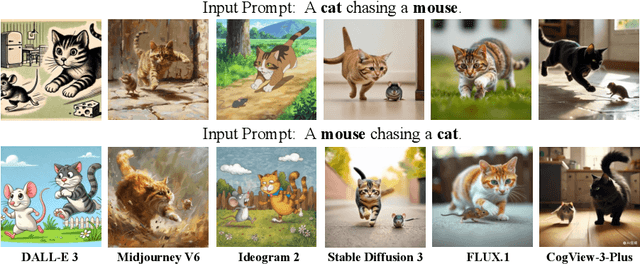
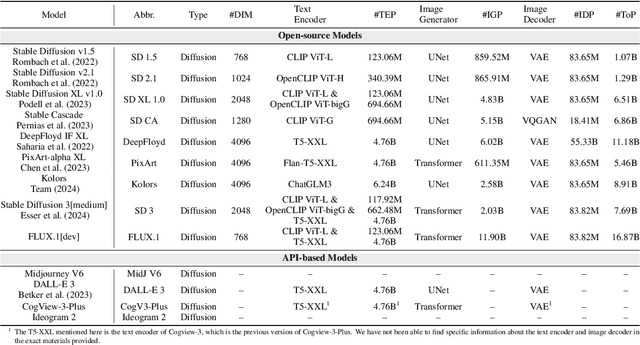
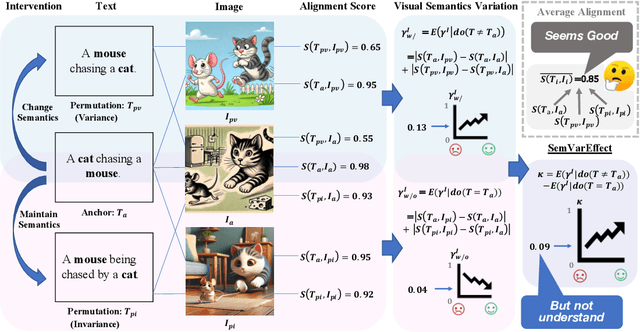
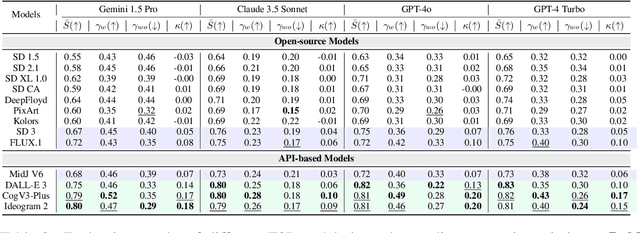
Abstract:Accurate interpretation and visualization of human instructions are crucial for text-to-image (T2I) synthesis. However, current models struggle to capture semantic variations from word order changes, and existing evaluations, relying on indirect metrics like text-image similarity, fail to reliably assess these challenges. This often obscures poor performance on complex or uncommon linguistic patterns by the focus on frequent word combinations. To address these deficiencies, we propose a novel metric called SemVarEffect and a benchmark named SemVarBench, designed to evaluate the causality between semantic variations in inputs and outputs in T2I synthesis. Semantic variations are achieved through two types of linguistic permutations, while avoiding easily predictable literal variations. Experiments reveal that the CogView-3-Plus and Ideogram 2 performed the best, achieving a score of 0.2/1. Semantic variations in object relations are less understood than attributes, scoring 0.07/1 compared to 0.17-0.19/1. We found that cross-modal alignment in UNet or Transformers plays a crucial role in handling semantic variations, a factor previously overlooked by a focus on textual encoders. Our work establishes an effective evaluation framework that advances the T2I synthesis community's exploration of human instruction understanding.
Learning Social Graph for Inactive User Recommendation
May 08, 2024

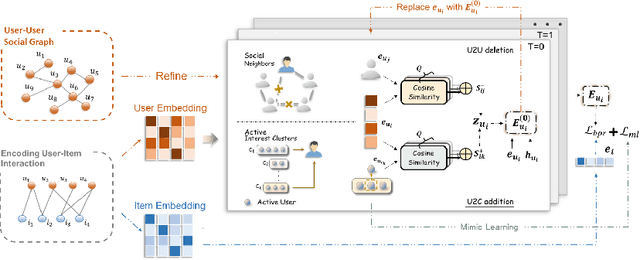
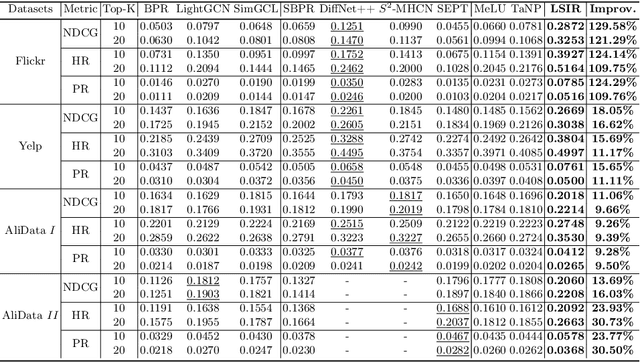
Abstract:Social relations have been widely incorporated into recommender systems to alleviate data sparsity problem. However, raw social relations don't always benefit recommendation due to their inferior quality and insufficient quantity, especially for inactive users, whose interacted items are limited. In this paper, we propose a novel social recommendation method called LSIR (\textbf{L}earning \textbf{S}ocial Graph for \textbf{I}nactive User \textbf{R}ecommendation) that learns an optimal social graph structure for social recommendation, especially for inactive users. LSIR recursively aggregates user and item embeddings to collaboratively encode item and user features. Then, graph structure learning (GSL) is employed to refine the raw user-user social graph, by removing noisy edges and adding new edges based on the enhanced embeddings. Meanwhile, mimic learning is implemented to guide active users in mimicking inactive users during model training, which improves the construction of new edges for inactive users. Extensive experiments on real-world datasets demonstrate that LSIR achieves significant improvements of up to 129.58\% on NDCG in inactive user recommendation. Our code is available at~\url{https://github.com/liun-online/LSIR}.
A Model-based Multi-Agent Personalized Short-Video Recommender System
May 03, 2024



Abstract:Recommender selects and presents top-K items to the user at each online request, and a recommendation session consists of several sequential requests. Formulating a recommendation session as a Markov decision process and solving it by reinforcement learning (RL) framework has attracted increasing attention from both academic and industry communities. In this paper, we propose a RL-based industrial short-video recommender ranking framework, which models and maximizes user watch-time in an environment of user multi-aspect preferences by a collaborative multi-agent formulization. Moreover, our proposed framework adopts a model-based learning approach to alleviate the sample selection bias which is a crucial but intractable problem in industrial recommender system. Extensive offline evaluations and live experiments confirm the effectiveness of our proposed method over alternatives. Our proposed approach has been deployed in our real large-scale short-video sharing platform, successfully serving over hundreds of millions users.
GraphTranslator: Aligning Graph Model to Large Language Model for Open-ended Tasks
Feb 28, 2024



Abstract:Large language models (LLMs) like ChatGPT, exhibit powerful zero-shot and instruction-following capabilities, have catalyzed a revolutionary transformation across diverse fields, especially for open-ended tasks. While the idea is less explored in the graph domain, despite the availability of numerous powerful graph models (GMs), they are restricted to tasks in a pre-defined form. Although several methods applying LLMs to graphs have been proposed, they fail to simultaneously handle the pre-defined and open-ended tasks, with LLM as a node feature enhancer or as a standalone predictor. To break this dilemma, we propose to bridge the pretrained GM and LLM by a Translator, named GraphTranslator, aiming to leverage GM to handle the pre-defined tasks effectively and utilize the extended interface of LLMs to offer various open-ended tasks for GM. To train such Translator, we propose a Producer capable of constructing the graph-text alignment data along node information, neighbor information and model information. By translating node representation into tokens, GraphTranslator empowers an LLM to make predictions based on language instructions, providing a unified perspective for both pre-defined and open-ended tasks. Extensive results demonstrate the effectiveness of our proposed GraphTranslator on zero-shot node classification. The graph question answering experiments reveal our GraphTranslator potential across a broad spectrum of open-ended tasks through language instructions. Our code is available at: https://github.com/alibaba/GraphTranslator.
GraphGPT: Graph Learning with Generative Pre-trained Transformers
Dec 31, 2023Abstract:We introduce \textit{GraphGPT}, a novel model for Graph learning by self-supervised Generative Pre-training Transformers. Our model transforms each graph or sampled subgraph into a sequence of tokens representing the node, edge and attributes reversibly using the Eulerian path first. Then we feed the tokens into a standard transformer decoder and pre-train it with the next-token-prediction (NTP) task. Lastly, we fine-tune the GraphGPT model with the supervised tasks. This intuitive, yet effective model achieves superior or close results to the state-of-the-art methods for the graph-, edge- and node-level tasks on the large scale molecular dataset PCQM4Mv2, the protein-protein association dataset ogbl-ppa and the ogbn-proteins dataset from the Open Graph Benchmark (OGB). Furthermore, the generative pre-training enables us to train GraphGPT up to 400M+ parameters with consistently increasing performance, which is beyond the capability of GNNs and previous graph transformers. The source code and pre-trained checkpoints will be released soon\footnote{\url{https://github.com/alibaba/graph-gpt}} to pave the way for the graph foundation model research, and also to assist the scientific discovery in pharmaceutical, chemistry, material and bio-informatics domains, etc.
Uniform Sequence Better: Time Interval Aware Data Augmentation for Sequential Recommendation
Dec 16, 2022Abstract:Sequential recommendation is an important task to predict the next-item to access based on a sequence of interacted items. Most existing works learn user preference as the transition pattern from the previous item to the next one, ignoring the time interval between these two items. However, we observe that the time interval in a sequence may vary significantly different, and thus result in the ineffectiveness of user modeling due to the issue of \emph{preference drift}. In fact, we conducted an empirical study to validate this observation, and found that a sequence with uniformly distributed time interval (denoted as uniform sequence) is more beneficial for performance improvement than that with greatly varying time interval. Therefore, we propose to augment sequence data from the perspective of time interval, which is not studied in the literature. Specifically, we design five operators (Ti-Crop, Ti-Reorder, Ti-Mask, Ti-Substitute, Ti-Insert) to transform the original non-uniform sequence to uniform sequence with the consideration of variance of time intervals. Then, we devise a control strategy to execute data augmentation on item sequences in different lengths. Finally, we implement these improvements on a state-of-the-art model CoSeRec and validate our approach on four real datasets. The experimental results show that our approach reaches significantly better performance than the other 11 competing methods. Our implementation is available: https://github.com/KingGugu/TiCoSeRec.
Gating-adapted Wavelet Multiresolution Analysis for Exposure Sequence Modeling in CTR prediction
Apr 29, 2022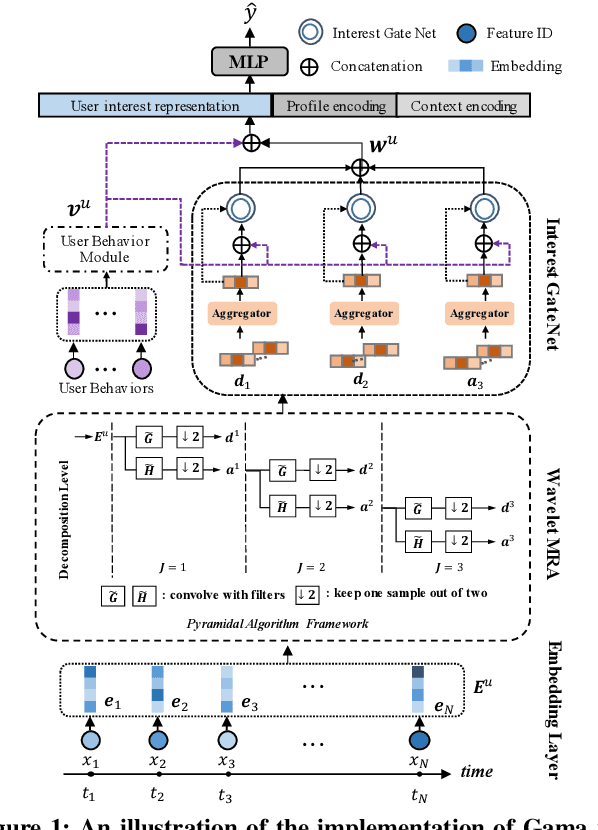

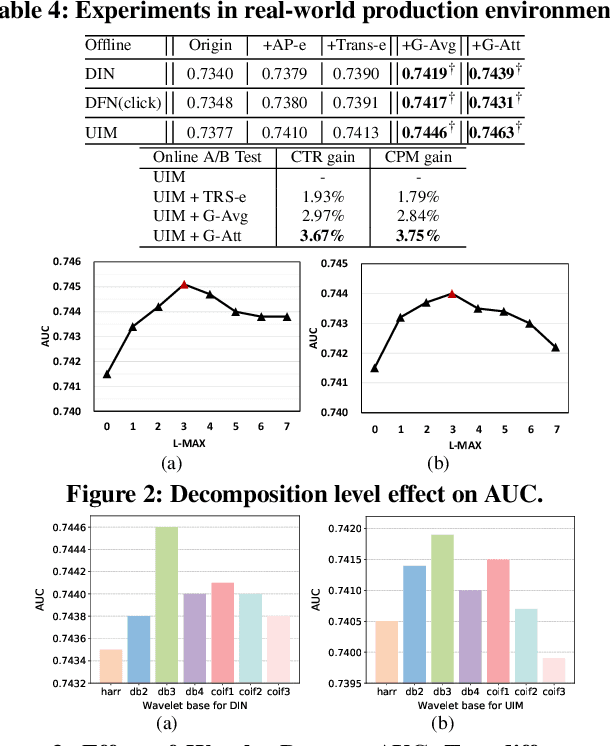
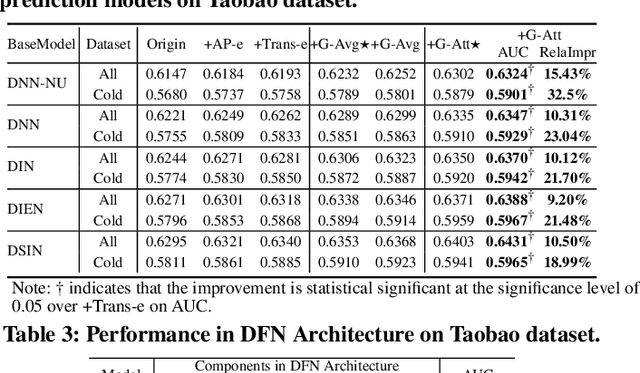
Abstract:The exposure sequence is being actively studied for user interest modeling in Click-Through Rate (CTR) prediction. However, the existing methods for exposure sequence modeling bring extensive computational burden and neglect noise problems, resulting in an excessively latency and the limited performance in online recommenders. In this paper, we propose to address the high latency and noise problems via Gating-adapted wavelet multiresolution analysis (Gama), which can effectively denoise the extremely long exposure sequence and adaptively capture the implied multi-dimension user interest with linear computational complexity. This is the first attempt to integrate non-parametric multiresolution analysis technique into deep neural networks to model user exposure sequence. Extensive experiments on large scale benchmark dataset and real production dataset confirm the effectiveness of Gama for exposure sequence modeling, especially in cold-start scenarios. Benefited from its low latency and high effecitveness, Gama has been deployed in our real large-scale industrial recommender, successfully serving over hundreds of millions users.
Alleviating Cold-start Problem in CTR Prediction with A Variational Embedding Learning Framework
Jan 17, 2022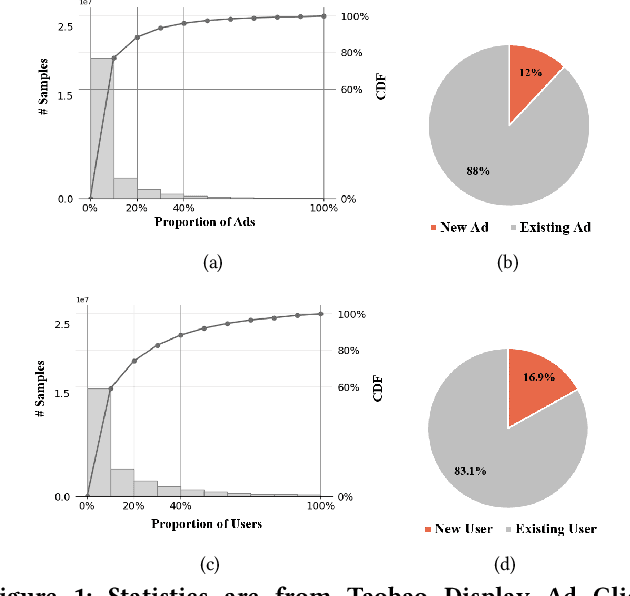

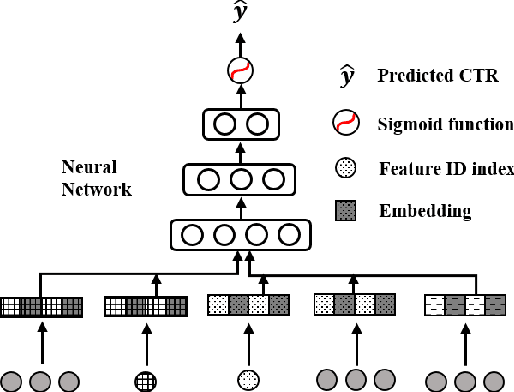

Abstract:We propose a general Variational Embedding Learning Framework (VELF) for alleviating the severe cold-start problem in CTR prediction. VELF addresses the cold start problem via alleviating over-fits caused by data-sparsity in two ways: learning probabilistic embedding, and incorporating trainable and regularized priors which utilize the rich side information of cold start users and advertisements (Ads). The two techniques are naturally integrated into a variational inference framework, forming an end-to-end training process. Abundant empirical tests on benchmark datasets well demonstrate the advantages of our proposed VELF. Besides, extended experiments confirmed that our parameterized and regularized priors provide more generalization capability than traditional fixed priors.
Learning Universal User Representations via Self-Supervised Lifelong Behaviors Modeling
Oct 25, 2021



Abstract:Universal user representation is an important research topic in industry, and is widely used in diverse downstream user analysis tasks, such as user profiling and user preference prediction. With the rapid development of Internet service platforms, extremely long user behavior sequences have been accumulated. However, existing researches have little ability to model universal user representation based on lifelong sequences of user behavior since registration. In this study, we propose a novel framework called Lifelong User Representation Model (LURM) to tackle this challenge. Specifically, LURM consists of two cascaded sub-models: (i) Bag of Interests (BoI) encodes user behaviors in any time period into a sparse vector with super-high dimension (e.g.,105); (ii) Self-supervised Multi-anchor EncoderNetwork (SMEN) maps sequences of BoI features to multiple low-dimensional user representations by contrastive learning. SMEN achieves almost lossless dimensionality reduction, benefiting from a novel multi-anchor module which can learn different aspects of user preferences. Experiments on several benchmark datasets show that our approach outperforms state-of-the-art unsupervised representation methods in downstream tasks
 Add to Chrome
Add to Chrome Add to Firefox
Add to Firefox Add to Edge
Add to Edge